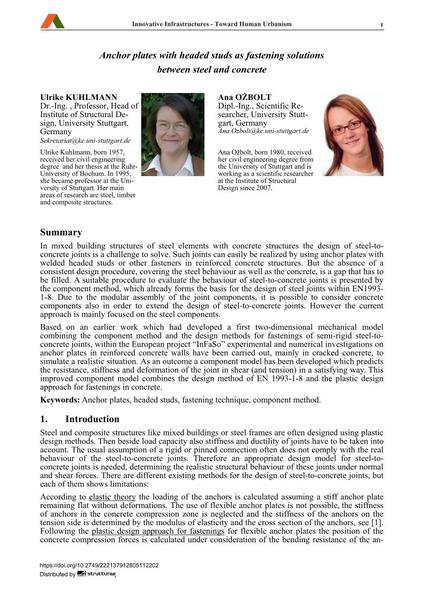Anchor plates with headed studs as fastening solutions between steel and concrete

|
|
|||||||||||
Bibliografische Angaben
| Autor(en): |
Ulrike Kuhlmann
Ana Ožbolt |
||||
|---|---|---|---|---|---|
| Medium: | Tagungsbeitrag | ||||
| Sprache(n): | Englisch | ||||
| Tagung: | 18th IABSE Congress: Innovative Infrastructures – Towards Human Urbanism, Seoul, Korea, 19-21 September 2012 | ||||
| Veröffentlicht in: | IABSE Congress Seoul 2012 | ||||
|
|||||
| Seite(n): | 1597-1604 | ||||
| Anzahl der Seiten (im PDF): | 8 | ||||
| DOI: | 10.2749/222137912805112202 | ||||
| Abstrakt: |
In mixed building structures of steel elements with concrete structures the design of steel-to- concrete joints is a challenge to solve. Such joints can easily be realized by using anchor plates with welded headed studs or other fasteners in reinforced concrete structures. But the absence of a consistent design procedure, covering the steel behaviour as well as the concrete, is a gap that has to be filled. A suitable procedure to evaluate the behaviour of steel-to-concrete joints is presented by the component method, which already forms the basis for the design of steel joints within EN1993- 1-8. Due to the modular assembly of the joint components, it is possible to consider concrete components also in order to extend the design of steel-to-concrete joints. However the current approach is mainly focused on the steel components. Based on an earlier work which had developed a first two-dimensional mechanical model combining the component method and the design methods for fastenings of semi-rigid steel-to- concrete joints, within the European project “InFaSo” experimental and numerical investigations on anchor plates in reinforced concrete walls have been carried out, mainly in cracked concrete, to simulate a realistic situation. As an outcome a component model has been developed which predicts the resistance, stiffness and deformation of the joint in shear (and tension) in a satisfying way. This improved component model combines the design method of EN 1993-1-8 and the plastic design approach for fastenings in concrete. |
||||
| Stichwörter: |
Komponentenmethode Ankerplatten
|
||||
